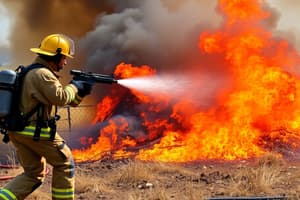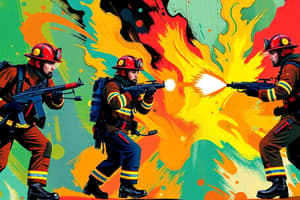Podcast
Questions and Answers
What is the primary goal of an offensive fire attack?
What is the primary goal of an offensive fire attack?
- To knock down the fire and cool interior spaces (correct)
- To isolate the fire from nearby structures
- To prevent the fire from spreading outdoors
- To ensure no fuel sources are available
Which technique is most effective when extinguishing a fire with water?
Which technique is most effective when extinguishing a fire with water?
- Using a fog stream to maximize droplet dispersion
- Utilizing multiple hose lines from various angles
- Applying water from the exterior of the building
- Directing water onto the burning fuels and interior surfaces (correct)
When is it most effective to start a fire attack from the exterior?
When is it most effective to start a fire attack from the exterior?
- When firefighters have inadequate water supply
- When the fire has spread to multiple floors
- When the fire begins on the exterior of a building (correct)
- When ventilation has been established
What should firefighters do if they must attack from the exhaust portion of a flow path?
What should firefighters do if they must attack from the exhaust portion of a flow path?
What complicates the fire attack in commercial occupancies compared to residential spaces?
What complicates the fire attack in commercial occupancies compared to residential spaces?
What is a key consideration when determining if more water is needed for an initial attack?
What is a key consideration when determining if more water is needed for an initial attack?
What should be avoided during a simultaneous fire attack on both exterior and interior spaces?
What should be avoided during a simultaneous fire attack on both exterior and interior spaces?
What effect does cooling the interior environment have when attacking a fire?
What effect does cooling the interior environment have when attacking a fire?
What is the safest practice for firefighters regarding wind conditions during a fire attack?
What is the safest practice for firefighters regarding wind conditions during a fire attack?
What is crucial to control during an interior fire attack in wind-driven conditions?
What is crucial to control during an interior fire attack in wind-driven conditions?
Why must hose lines that have been operated in the same place for long periods be monitored?
Why must hose lines that have been operated in the same place for long periods be monitored?
What is a limitation of using fire streams from above in confined spaces?
What is a limitation of using fire streams from above in confined spaces?
What is the best method for extinguishing basement fires?
What is the best method for extinguishing basement fires?
What should be done if there is no exterior access to a basement fire?
What should be done if there is no exterior access to a basement fire?
Who is responsible for the effectiveness of fire streams during operations?
Who is responsible for the effectiveness of fire streams during operations?
What knowledge must Company Officers possess regarding nozzle operations?
What knowledge must Company Officers possess regarding nozzle operations?
What is a primary factor in determining whether to increase water supply during a fire attack?
What is a primary factor in determining whether to increase water supply during a fire attack?
Which method is most effective for cooling interior environments during a fire attack?
Which method is most effective for cooling interior environments during a fire attack?
What is the recommended sequence of fire attack for a fire starting externally?
What is the recommended sequence of fire attack for a fire starting externally?
What is a critical factor when firefighters must work within the flow path at a structure fire?
What is a critical factor when firefighters must work within the flow path at a structure fire?
What might be the effect of changing the ventilation profile during a fire attack?
What might be the effect of changing the ventilation profile during a fire attack?
Why is caution required when firefighters attack from the exhaust portion of the flow path?
Why is caution required when firefighters attack from the exhaust portion of the flow path?
What complicates fire control efforts in commercial occupancies compared to residential fires?
What complicates fire control efforts in commercial occupancies compared to residential fires?
What should firefighters prioritize when using water to extinguish an interior fire?
What should firefighters prioritize when using water to extinguish an interior fire?
What is the role of Company Officers in fire operations?
What is the role of Company Officers in fire operations?
Why is it crucial to manage ventilation intake on the windward side during an interior fire attack?
Why is it crucial to manage ventilation intake on the windward side during an interior fire attack?
What should firefighters be cautious about when backing up an initial fire attack?
What should firefighters be cautious about when backing up an initial fire attack?
What is a potential challenge when applying water through confined spaces like attics?
What is a potential challenge when applying water through confined spaces like attics?
When facing basement fires without external access, what is the best approach?
When facing basement fires without external access, what is the best approach?
What must firefighters continually evaluate during fire operations?
What must firefighters continually evaluate during fire operations?
What can be a consequence of operating hose lines in the same location for extended periods?
What can be a consequence of operating hose lines in the same location for extended periods?
What is the primary concern when applying water to a basement fire accessed only from above?
What is the primary concern when applying water to a basement fire accessed only from above?
Flashcards are hidden until you start studying
Study Notes
Offensive Fire Strategy Considerations
- Objective: The main goal of an offensive fire attack is to suppress the fire and cool interior spaces, enhancing survivability for potential victims and working conditions for firefighters.
- Incomplete Control: If initial fire control is not achieved, assess whether more water is needed or whether alternate attack positions (interior/exterior) should be utilized.
Fire Extinguishment Techniques
- Water Effectiveness: Fire behavior studies indicate that applying water directly to hot surfaces and fuels inside a compartment is the most effective firefighting method.
- Stream Type: Use a straight or solid bore stream to maximize water droplet size, which minimizes steam production and efficiently cools hot gases.
Residential vs. Commercial Fires
- Small Residential Spaces: Water application is more manageable and effective in smaller residential settings where positioning allows direct access to interior surfaces.
- Complex Commercial Settings: Challenges increase in larger, more complex commercial buildings, making fire control more difficult.
Exterior Fire Considerations
- External Origins: For fires originating on the exterior, start suppression efforts externally before progressing inside to prevent the interior fire from being fed by the external blaze.
- Simultaneous Attack: When feasible, conduct simultaneous attacks on both the exterior and interior to achieve optimal results.
Flow Path Identification
- Flow Path Understanding: Early recognition of a flow path helps firefighters strategize their approach, targeting the intake rather than working against it.
- Caution in Exhaust Areas: If forced to attack from the exhaust side of the flow path, extreme caution is necessary due to potential risks.
Ventilation and Wind Conditions
- Ventilation Coordination: Changes to the ventilation profile can alter flow path directions; coordination is essential to ensure safety during firefighting.
- Wind Considerations: Initiate fire attacks with the wind at firefighters' backs to mitigate risks from wind-driven fire conditions; uncontrolled ventilation can be dangerous.
Backup Strategies
- Stream Matching: Backup fire streams should match or exceed the initial attack flow to maintain effectiveness.
- Dynamic Conditions: Continuously evaluate fire conditions as they evolve; adjust or redeploy hose lines if they become ineffective.
Limitations of Fire Streams
- Confined Spaces: Be aware of challenges when operating nozzles in small openings; mobility is restricted, making effective surface cooling difficult.
- Application Angle: In confined spaces like attics, it is hard to target the underside and structural components directly with water.
Basement Fire Strategies
- Access Level: The most effective extinguishment of basement fires occurs when water is applied from the same level as the fire source.
- Access Challenges: Without direct exterior access, firefighters must cool the environment via windows or face significant risk when entering through upper floors.
Officer Responsibilities
- Stream Effectiveness: Company Officers and Sector Officers must monitor and report the effectiveness and directions of their fire streams.
- Nozzle Proficiency: Officers must be knowledgeable about nozzle characteristics to achieve optimal stream volume and efficiency during firefighting operations.
Offensive Fire Strategy Considerations
- Objective: The main goal of an offensive fire attack is to suppress the fire and cool interior spaces, enhancing survivability for potential victims and working conditions for firefighters.
- Incomplete Control: If initial fire control is not achieved, assess whether more water is needed or whether alternate attack positions (interior/exterior) should be utilized.
Fire Extinguishment Techniques
- Water Effectiveness: Fire behavior studies indicate that applying water directly to hot surfaces and fuels inside a compartment is the most effective firefighting method.
- Stream Type: Use a straight or solid bore stream to maximize water droplet size, which minimizes steam production and efficiently cools hot gases.
Residential vs. Commercial Fires
- Small Residential Spaces: Water application is more manageable and effective in smaller residential settings where positioning allows direct access to interior surfaces.
- Complex Commercial Settings: Challenges increase in larger, more complex commercial buildings, making fire control more difficult.
Exterior Fire Considerations
- External Origins: For fires originating on the exterior, start suppression efforts externally before progressing inside to prevent the interior fire from being fed by the external blaze.
- Simultaneous Attack: When feasible, conduct simultaneous attacks on both the exterior and interior to achieve optimal results.
Flow Path Identification
- Flow Path Understanding: Early recognition of a flow path helps firefighters strategize their approach, targeting the intake rather than working against it.
- Caution in Exhaust Areas: If forced to attack from the exhaust side of the flow path, extreme caution is necessary due to potential risks.
Ventilation and Wind Conditions
- Ventilation Coordination: Changes to the ventilation profile can alter flow path directions; coordination is essential to ensure safety during firefighting.
- Wind Considerations: Initiate fire attacks with the wind at firefighters' backs to mitigate risks from wind-driven fire conditions; uncontrolled ventilation can be dangerous.
Backup Strategies
- Stream Matching: Backup fire streams should match or exceed the initial attack flow to maintain effectiveness.
- Dynamic Conditions: Continuously evaluate fire conditions as they evolve; adjust or redeploy hose lines if they become ineffective.
Limitations of Fire Streams
- Confined Spaces: Be aware of challenges when operating nozzles in small openings; mobility is restricted, making effective surface cooling difficult.
- Application Angle: In confined spaces like attics, it is hard to target the underside and structural components directly with water.
Basement Fire Strategies
- Access Level: The most effective extinguishment of basement fires occurs when water is applied from the same level as the fire source.
- Access Challenges: Without direct exterior access, firefighters must cool the environment via windows or face significant risk when entering through upper floors.
Officer Responsibilities
- Stream Effectiveness: Company Officers and Sector Officers must monitor and report the effectiveness and directions of their fire streams.
- Nozzle Proficiency: Officers must be knowledgeable about nozzle characteristics to achieve optimal stream volume and efficiency during firefighting operations.
Studying That Suits You
Use AI to generate personalized quizzes and flashcards to suit your learning preferences.




